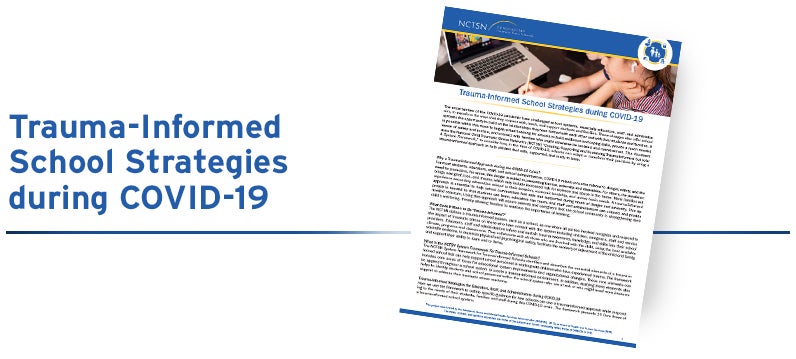

![]()
Trauma-Informed School Strategies during COVID-19
Provides trauma-informed school strategies in response to COVID-19. This fact sheet offers information on the physical and emotional well-being of staff, creating a trauma-informed learning environment, identifying and assessing traumatic stress, addressing and treating traumatic stress, trauma education and awareness, partnerships with students and families, cultural responsiveness, emergency management and crisis response, and school discipline policies and practices.
![]()
Keeping Yourself and Your Kids Safe and Healthy in the Pandemic:
Tips for Judges, Legal Professionals, and Court Personnel
Offers helpful questions about safety that judges, legal professionals, and court personnel can ask themselves regarding their work and their personal lives. This fact sheet also provides basic steps to help youth handle stress during COVID-19, as well as do's and don'ts for working with children and families in a pandemic.
![]()
The Impact of COVID-19 on Child Sex and Labor Trafficking
Describes how the impact and consequences of COVID-19 increase the risk of involvement in sex or labor trafficking. This fact sheet offers information on what you can do as a provider and how to support and take care of yourself during this unprecedented time.
![]()
Now Available in Spanish — Children and Domestic Violence for Parents Fact Sheet Series
This fact sheet series offers support to parents whose children have been affected by intimate partner violence. Provides parents with information on a number of topics, including but not limited to how children may react and how to talk to children about intimate partner violence.
Upcoming Webinar:
Culturally-Responsive Approaches to Serve Latin American Children who Experience Traumatic Separation
Date/Time: Friday June 26th at 9:00 AM PT/ 12:00 PM ETPresenters: Marisa Chumil, MSW, Deputy Director of Social Work, Young Center for Immigrant Children’s Rights; Stacey Frymier, LPCC, LPAT-ATR, IMH-E®(IV-C), Director of Community Youth and Caregiver Programs, Las Cumbres Community Services, Inc.; Jose Gonzalez, Program Manager and Family Navigator, Las Cumbres Community Services, Inc.; Javier Rosado, PhD, Clinical Associate Professor, Florida State University College of Medicine, Immokalee Health Education Site, and Clinical Director, FSU Center for Child Stress & Health. Moderated by Diane Elmore Borbon, PhD, MPH, UCLA-Duke University National Center for Child Traumatic Stress
In this webinar, experts from diverse service sectors will explore trauma-informed, culturally-responsive strategies for serving separated children who have migrated to the US from countries in Latin America. They will discuss policies and practices relevant to the protection and best interests of unaccompanied and separated immigrant children. Presenters will also give viewers an overview of a project providing mental health care and family navigation services for Latino immigrant families along the US southern border and community-based interventions in rural northern New Mexico. In addition, they will identify clinical challenges and strategies for serving migrant children and families in a primary health care setting. Sponsored by the NCCTS Policy Program, the NCTSN Policy Task Force, and the NCTSN Culture Consortium.

How is COVID-19 Impacting Refugee and Immigrant Communities?
In this 12-minute webinar, Drs. Luna A. Mulder and Jeffrey P. Winer, psychologists at the Refugee Trauma and Resilience Center at Boston Children's Hospital/Harvard Medical School, provide a brief overview of ways that COVID-19 has impacted refugee and immigrant communities and what organizations are doing to respond.
![]()
COVID-19 Special Needs Resources: Information for Families with A Child with an Intellectual and/or Developmental Disability (I/DD) during the COVID-19 Pandemic
The NCTSN STRYDD Center (Supporting Trauma Recovery for Youth with Developmental Disabilities) Long Island Jewish Medical Center, Northwell Health created resources to help parents support their child with special needs during COVID-19. Some resources address all children, while some were developed specifically for children with I/DD and/or Autism. Resources include an overview guide, tools for helping children cope, activities for learning and fun, and more.
![]()
New Children’s Book — The Germ That Wears a Crown: A Story About the Coronavirus
This story, coloring, and activity book is designed to help caregivers talk with children about COVID-19, social distancing, and how to express and manage strong emotions triggered by the outbreak.
![]()
RECENT JOURNAL PUBLICATIONS
Authored by Patricia Kerig and Crosby Modrowski, Investigating the Association Between Posttraumatic Risky Behavior and Offending in Adolescents Involved in the Juvenile Justice System examines predictors of posttraumatic risky behavior, the unique contribution of posttraumatic risky behavior in predicting offending, and tested whether a distinct class of youth was characterized by high levels of posttraumatic risky behavior. Participants were 400 adolescents (25% girls) between the ages of 12 and 19 years old (M = 15.97, SD = 1.25) who were involved in the Utah juvenile justice system. Approximately 54% of the sample identified as an ethnic minority. Youth completed self-report measures of trauma exposure, posttraumatic risky behavior, posttraumatic stress symptom severity, and offending. Formal legal records of offending were also collected. The results indicated that female sex was significantly related to posttraumatic risky behavior, though age was not significantly associated with posttraumatic risky behavior. Age and ethnicity were associated with both self-reported and formal offending, and male sex was associated with formal offending. Posttraumatic risky behavior was not related to formal offending, but was related to self-reported offending in some of the tested models. Latent class analysis identified 92 youth characterized by high levels of posttraumatic risky behavior; these youth also evidenced the highest rates of trauma exposure, posttraumatic stress symptom severity, and self-reported offending. There were no ethnic, age, or sex differences between youth in the high and low posttraumatic risky behavior groups. These results add to the extant literature documenting the associations among exposure to trauma, posttraumatic stress, and juvenile offending.
Looking for Trainings?
Visit the NCTSN Training Page on LinkedIn
Not on our mailing list? Click here to sign up.
This project was funded by the Substance Abuse and Mental Health Services Administration (SAMHSA), US Department of Health and Human Services (HHS). The views, policies, and opinions expressed are those of the authors and do not necessarily reflect those of SAMHSA or HHS.

